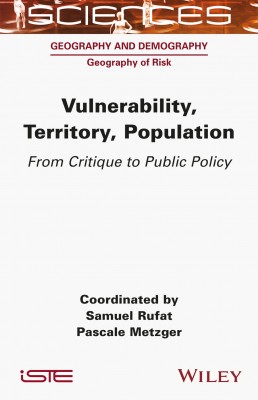
During the Covid-19 pandemic, the term “vulnerable” was applied to “individuals” and to “populations”, “groups” and “countries” in discussions, laws and regulations; now it applies to all objects in relation to all kinds of threats.
However, rather than a label for governing people and places, the notion of “vulnerability” was expected to become an instrument to tackle the root causes of disasters, poverty and maldevelopment, as well as the inequalities and injustices they bring, whether social, political, economic or environmental. Despite this radical dimension, vulnerability has gradually been incorporated into public policies and international recommendations for global risk and disaster management.
This book is intended for researchers, students, managers and decision makers concerned with the management of not only risks and crises but also climate and environmental change.
The first part examines the multiple theoretical and conceptual approaches; the second explores vulnerability assessments, using examples from the Global North and Global South; and the third discusses tools, public policies and actions taken to reduce vulnerability.
Part 1. The Multiple Theoretical and Conceptual Approaches to Vulnerability.
1. Plural Vulnerabilities: Approaches in the Humanities, Sylvia Becerra and Anne Peltier.
2. Conceptual Models of Vulnerability or Vulnerabilities, Samuel Rufat.
3. Risks, Crises and Ordinary Vulnerability, Pascale Metzger.
4. Vulnerabilities, Risk Governance and the Interplay of Stakeholders, Julien LANGUMIER.
Part 2. Territorial Approaches and Vulnerability Assessments.
5. The Challenge of Measuring and Operationalizing Vulnerabilities, Samuel RUFAT.
6. Assessing Territorial Vulnerability: Concepts and Methods for an Integrated Approach to Vulnerability, Elise Beck and Jérémy Robert.
7. Analyzing the Vulnerability of Networks and Critical Infrastructures, Serge LHOMME.
8. From the Health Vulnerability of Territories to the Reduction of Health Inequalities, Zoé Vaillant and Stéphane Rican.
Part 3. From Tools to Public Policies, Discourses and Actions.
9. What Are Vulnerability Maps For? Samuel Rufat and Patrick Pigeon.
10. Measuring Vulnerability: By Whom and for Whose Benefit? The Significance of Participation, Loïc Lé Dé, JC Gaillard, Louise Baumann and Jake Rom Cadag.
11. Vulnerability in a Time of Climate Change and Global Urbanization, Béatrice Quenault.
12. Actors and Discourses of Vulnerability Reduction: From International to Local, Sandrine Revet and Pascale Metzger.
Samuel Rufat is Professor at CY Cergy Paris University and the Institut Universitaire de France. His research interests include vulnerability, resilience, adaptation assessments, geospatial modeling, risk perception, emergency management and disaster mitigation.
Pascale Metzger is a researcher at the French National Research Institute for Sustainable Development (IRD) and a member of the Prodig laboratory. She studies risks and environment in the large cities of Latin America and highlights the role of social sciences on disaster risk reduction.